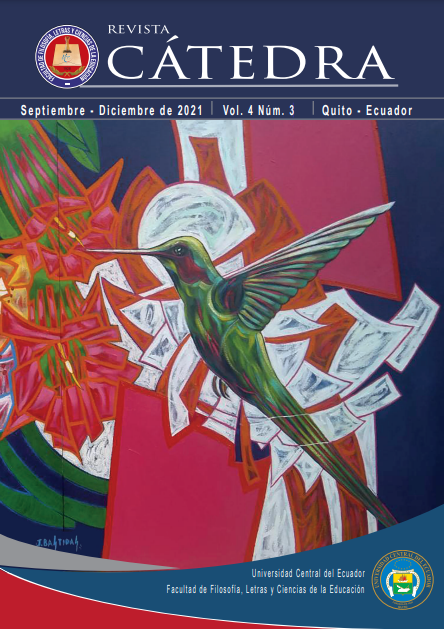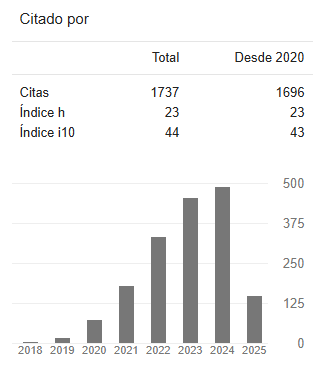Artistic languages and motor skills in the preparatory level of basic education
DOI:
https://doi.org/10.29166/catedra.v4i3.3151Keywords:
artistic languages, motor skills, artistic playful experiences, basic functions, preparatory basic educationAbstract
In the process of pre-professional practices carried out in the educational centers of the pre-school level of Ecuadorian basic general education, difficulties have been evidenced in the development of basic motor skills necessary for learning to read and write. The article is the result of a quasi-experimental study with a control group that proposes to integrate playful experiences with different artistic languages for the development of motor skills in boys and girls between 5 and 6 years old, in six schools located in different urban sectors and peri-urban areas of the city of Quito. It is based on the evaluation based on the test of basic functions taken before and after the application of playful learning experiences that introduce performing, musical and plastic-visual arts, appropriate to the learning objective in the experimentation and control groups of each school, to determine the differences in each group and in their contrast. The initial diagnosis shows a prevalence of more than 50% of students with deficits in motor skills. After the applied process and the post-test evaluation, a reduction of the deficit areas and a better development in the skills of lateral dominance, rhythm and visual-motor coordination is observed in the experimental group compared to the control group. It is concluded that the proposal that combines art and play helps in the development of gross and fine motor skills, necessary for the reading-writing process, observing, in addition, that this process promotes the free and spontaneous expression of children for a better personal and social development.
Downloads
References
Acurio, Y., Alcívar, A., Almeida, A., Aquieta, A., Amores, E., Mullo, E., Muso, J., Pajuña, A., Saltos, A., Sisalema, A. (2016). La importancia del juego en el desarrollo de la psicomotricidad en los niños de 3 a 5 años. Tesis sin publicar de pregrado. Universidad técnica de Cotopaxi. Latacunga- Cotopaxi, Ecuador.
Almeida, C. (2009). Desarrollo de Destrezas Motoras Básicas http://destrezasmotorasbasicas.blogspot.com/2009/01/conceptos.html
Azagra Solano, A., & Giménez Chornet, V. (2018). EL ARTE EN LA PRIMERA INFANCIA: PROPUESTAS DESTACABLES. Revista sobre la infancia y la adolescencia, 28.
Badii, M.H., A. Guillen, L.A. Araiza, E. Cerna, J. Valenzuela & J. Landeros (2012). Métodos no-paramétricos de uso común. Daena: International Journal of Good Conscience. 7(1) 132-155. ISSN 1870-557X 132. Saltillo Coah, México.
http://www.spentamexico.org/v7-n1/7(1)132-155.pdf
Bonilla, C.B.(1999).Una Aproximación al Concepto de Lúdica. Interpretaciones sobre la Cultura Corporal de los Adolescentes Escolares. Revista Kinesis N°22.
Da Fonseca, V. (1996). Estudio y génesis de la psicomotricidad. Barcelona: Editorial Independiente S.A.
Díaz, J. J., & Vargas, G. A. (2009). Efecto de una intervención motriz en el desarrollo motor, rendimiento académico y creatividad en preescolares. Revista de Ciencias del Ejercicio y la Salud, 7(1), 11-22.
Domínguez, C. (2015). La lúdica: Una estrategia pedagógica depreciada. http://www3.uacj.mx/DGDCDC/SP/Documents/RTI/2015/ICSA/La%20ludica.pdf
Espinosa, Iván (2010). Prueba de Neurofunciones o Funciones básicas, Adaptación UC- IE. Quito, Ecuador.
Estévez, M. A., & Rojas, A. L. (2017). La educación artística en la educación inicial. Un requerimiento de la formación del profesional. Universidad y Sociedad, 9(4), 114-119. http://rus.ucf.edu.cu/index.php/rus
Gómez Roldán, A. (2005). La lúdica en los procesos democráticos, participativos y pluralistas. Prolegómenos. Derechos y Valores, vol. VIII, núm. 16, Universidad Militar Nueva Granada. Bogotá, Colombia. https://www.redalyc.org/pdf/876/87616807.pdf
Guthrie, E. R. (1998). Habilidades motrices.
https://glosarios.servidor-alicante.com/educacion-fisica/habilidades-motrices
Ministerio de Educación (2010). Funciones Básicas. Guía de aplicación, evaluación y pautas básicas de recuperación pedagógica para estudiantes de los centros educativos del proyecto. Selección, adecuación y elaboración de Jorge Ibujés Portilla. Quito, Ecuador.
https://educacion.gob.ec/wp-content/uploads/downloads/2016/06/MANUAL-PRUEBA-FUNCIONES- BASICAS-EBSF_2105.pdf
Ministerio de Educación (2019). Educación General Básica. Currículo de los niveles de educación obligatoria. Nivel Preparatoria. Quito, Ecuador. https://educacion.gob.ec/wp-content/uploads/downloads/2019/09/EGB-Preparatoria.pdf
Montaño, J. (2020). Lifeder. Obtenido de Lenguaje artístico: concepto, características y tipos.
https://www.lifeder.com/lenguaje-artistico/
Quiles-Ros, G. (2013). Motricidad y rendimiento escolar: estudio de una muestra de tercero de educación primaria. España: Universidad de la Rioja.https://www.redalyc.org/pdf/1341/134146842009.pdf
Ruiz Pérez, LM. (1987). Desarrollo motor y actividades físicas. Gymnos, Madrid. https://www.efdeportes.com/efd147/habilidades-motrices-basicas-coordinacion-y-equilibrio.htm
Serrano, María Eugenia y Correa, Jorge Enrique (2014). Propiedades psicométricas del test de competencias motoras Bruininks Oseretsky en versión corta para niños entre 4 y 7 años en Chía y Bogotá, D.C., Colombia.









